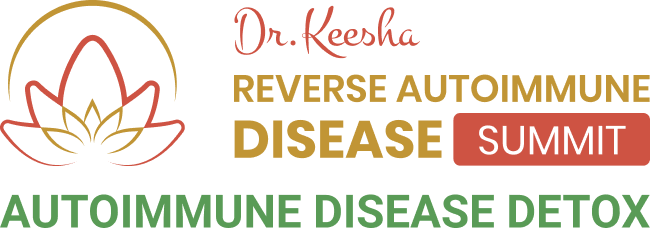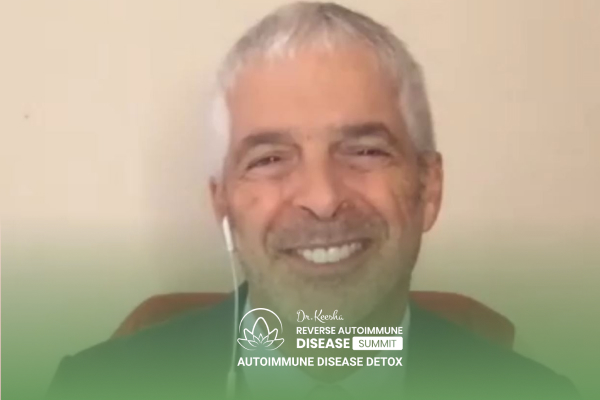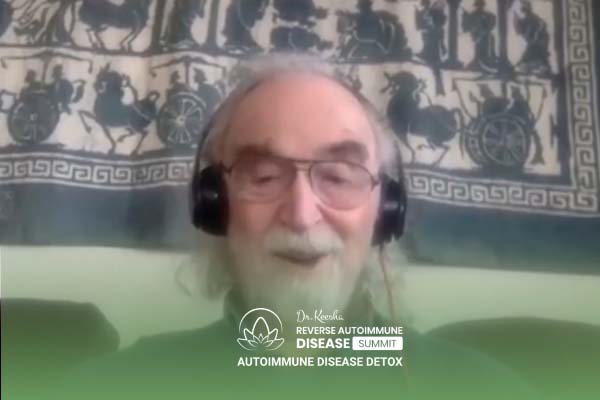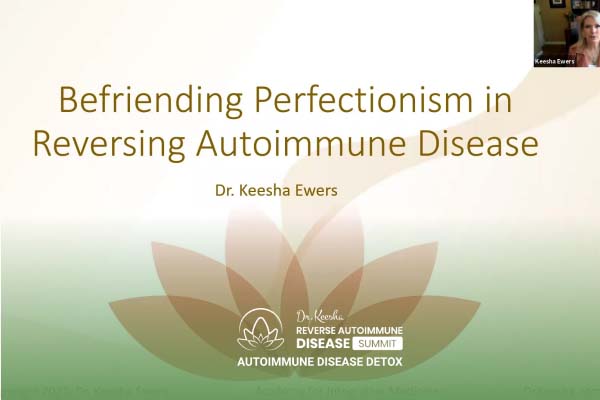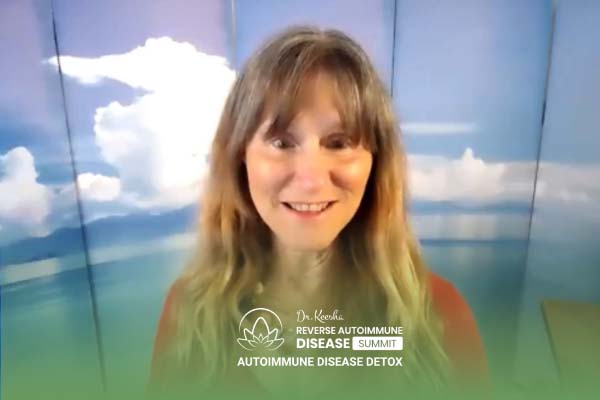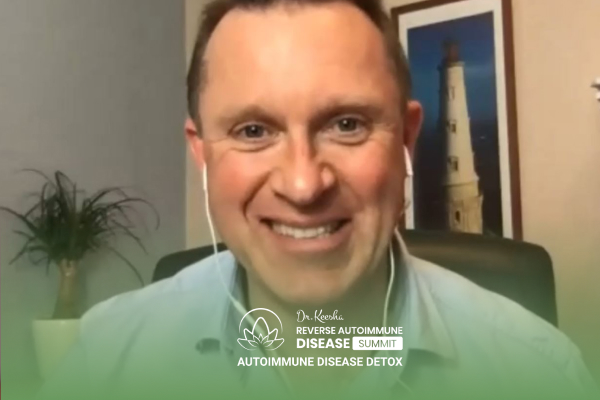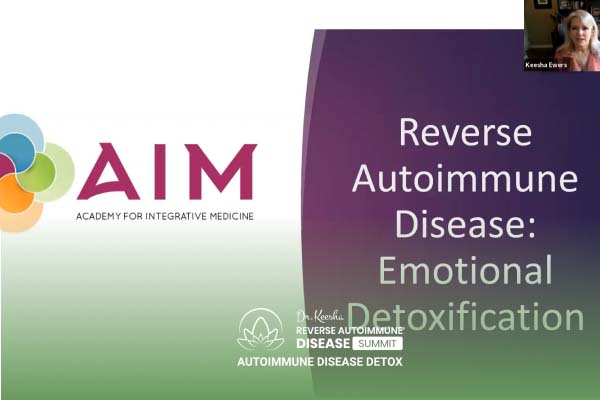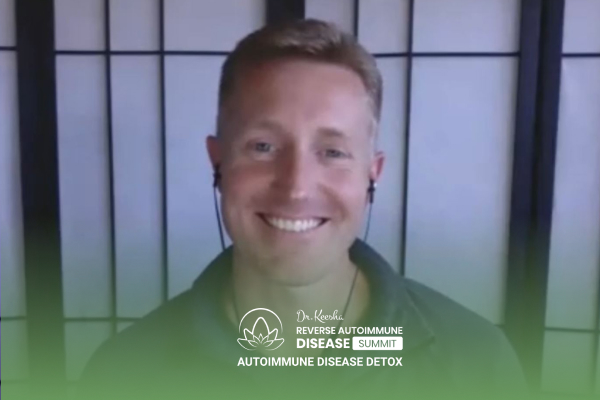Join the discussion below
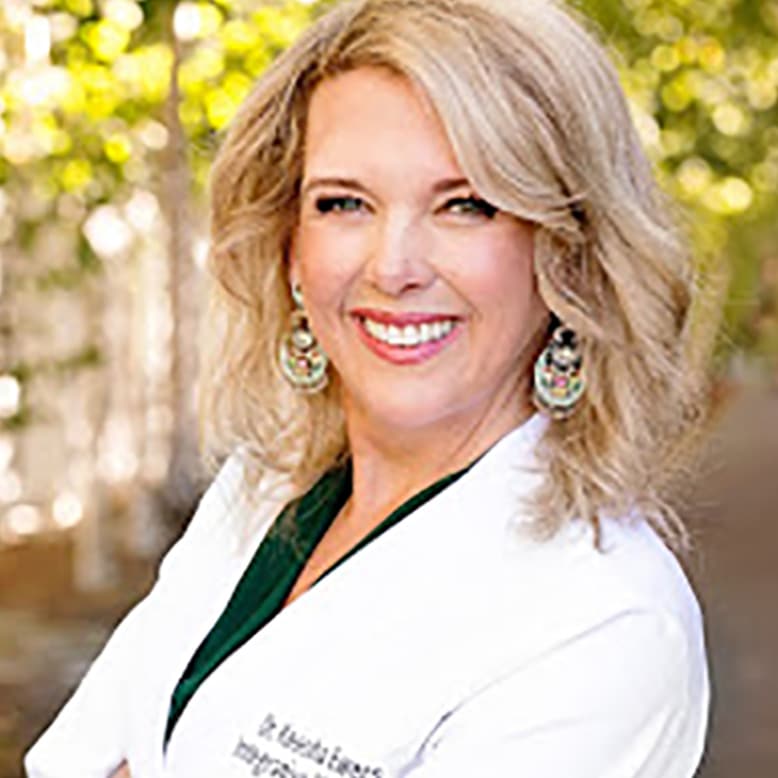
Keesha Ewers, PhD, ARNP-FNP-C, AAP, IFM-C
Dr. Keesha Ewers is an integrative medicine expert, Doctor of Sexology, Family Practice ARNP, Psychotherapist, herbalist, is board certified in functional medicine and Ayurvedic medicine, and is the founder and medical director of the Academy for Integrative Medicine Health Coach Certification Program. Dr. Keesha has been in the medical field... Read More

Tom O’Bryan, DC, CCN, DABCN, CIFM
Dr. O’Bryan is considered a ‘Sherlock Holmes’ for chronic disease and teaches that recognizing and addressing the underlying mechanisms that activate an immune response is the map to the highway toward better health. He holds teaching Faculty positions with the Institute for Functional Medicine and the National University of Health... Read More
• The three culprits that lead to cancer (that you’ve completely forgotten about)
• How to balance your hormones to live longer and feel great!
• Proven energy medicine that regenerates the body and protects from EMF exposure
Keesha Ewers, PhD, ARNP-FNP-C, AAP, IFM-C
Welcome back to the Autoimmune Detox Summit everybody. This is of course the fourth in the series of the reverse autoimmune disease summit series. And my next guest, of course I’m sure, bears no need for an introduction. Dr. Tom O-Bryan is considered the Sherlock Holmes for chronic disease and metabolic disorders. He’s a clinician par excellence in treating chronic disease and metabolic disorders from a functional medicine perspective. His 2016 critically acclaimed groundbreaking book, “The Autoimmune Fix” outlines the step-by-step development of degenerative diseases and gives us the tools to identify a disease process years before the symptoms are obvious. Winner of the National Book award and ranked number one in several categories on amazon.com. “The Autoimmune Fix” offers a cutting edge protocol on how to turn one’s life and health around one base hit at a time. His newest book, “You Can Fix Your Brain: Just 1 Hour a Week to the Best Memory, Productivity, and Sleep You’ve Ever Had” is the handbook for anyone worried about any type of brain ailment. From chronic conditions like dementia or brain disorders like Ms, to simple brain fog and fatigue. This essential guide covers the full spectrum and prevention to treatment. So Dr. O-Bryan, you have a much longer bio than this,
Tom O’Bryan, DC, CCN, DACBN, CIFM
Sorry.
Keesha Ewers, PhD, ARNP-FNP-C, AAP, IFM-C
No, I love it. And what I wanted to do is maybe unfold some of that as we were talking. One of the things that I was telling you before we turned on the recording was that the most frequently asked question that I’m getting these days is what about the COVID vaccination when I have autoimmune disease? And I thought, you know what, let’s talk about that with Dr. O-Bryan and see what emerges from this conversation. So somebody has autoimmune disease and they ask you this question, should I get the COVID vaccination?
Tom O’Bryan, DC, CCN, DACBN, CIFM
That’s really an interesting question. And I’m not quite sure the most accurate way to phrase this. So I’m just going to copycat on what our friend and fellow faculty, Dr. Datis Kharrazian said in the introduction to one of his books. He said, “If you are unwilling to give up wheat to prevent autoimmune diseases, close this book, don’t read it, don’t waste your time.” Right, you know, it’s like if you’re unwilling to listen and apply, what is rational, don’t even waste your time listening to this.
Keesha Ewers, PhD, ARNP-FNP-C, AAP, IFM-C
I love this as an intro.
Tom O’Bryan, DC, CCN, DACBN, CIFM
We all continually look for what’s the magic pill, what’s the magic bullet. How do I keep living my life the way that I do, and yet prevent something from happening to me that I’m at risk for? What do I take? What’s the magic pill? Before we started here we were talking about ivermectin for a minute, which is an extremely safe medication. Maybe we’ll get into it a little bit but if you have an autoimmune disease, should I get the vaccination? There are a number of components to keep in mind by which to make that decision. It’s not as simple as a yes or no, it’s not because we know.
The study was published six weeks ago. That tells us that the vaccination has the potential of triggering more autoimmune mechanisms in genetically vulnerable people. And the percentages are quite high, over 50% of those that were checked, develop antibodies to their brain or nerve tissue from the vaccination. And then I don’t remember the percentage for thyroid or for your joints but there were many different conditions, depending on your genetic vulnerability, as to where you may encourage the development of more autoimmune mechanisms.
And that’s because of molecular mimicry, the signature of this virus that the vaccination is going after and to make antibodies that injection, what you’re injected with, those antibodies can attack your own tissue because the signature of that virus that were injected with looks a lot like the signature of the collagen in your joints or the myelin in your nerves or the proteins in the cerebellum in your brain. They look really similar. So the antibodies are going after virus, going after virus, going after, oh look over there that kind of looks like virus and they attack your cerebellum or they attack myelin. So we know that happens as a result of this vaccination. And there’s no way to know. It’ll take five years or more after people have had the vaccination before you’ll see what percentage of people now have more autoimmune mechanisms going on as a result of this.
Keesha Ewers, PhD, ARNP-FNP-C, AAP, IFM-C
You mean, as a result of this gigantic medical experiment in which we are the lab rats.
Tom O’Bryan, DC, CCN, DACBN, CIFM
That’s exactly right. That there’s never been human trials for this. Yeah, and it’ll take a number of years before you see how much damage, what kind of a mechanism is going on in your body, killing off cells, killing off cells, killing off cells, which we know that’s what autoimmune mechanisms are. So how many new mechanisms do you have? And no one is doing the screening tests now, of how many different antibodies do I have to my own body, to my own tissue? No, one’s doing that. And then get the vaccine and then wait six months and do that same check again. Oh, look, I’ve got four more autoimmune mechanisms going on now. No one’s doing that.
And so I don’t know how we’ll conclusively be able to say five years from now, other than more people have autoimmune mechanisms going on that never before in history. I think that’s the only way we’ll be… And it likely was because of the vaccine they got five years ago, but there’s no way to prove that. And we’ll have the scientists from the pharmaceutical companies trashing that discussion any way they can. No, that’s not possible. Sure, it’s possible. Look at the science. We’re telling you now here’s the science, it’s published. It happens, but we don’t know what the numbers will be. So with all of that background, to answer the question, I have autoimmune mechanisms going on now should I get the vaccine?
The next component of the answer is what’s your vulnerability? Are you in the process of arresting the autoimmune mechanism? Have you done a followup test to see that your thyroid antibodies are much lower than they were? I mean, they’re still too high, but everything you’re doing to address your autoimmune thyroid disease, once you learned about it and you applied the principles from Dr. Keesha’s books, from my books, from her webinars, from my webinars, you’ve been applying these principles and now you’ve rechecked six months or a year later and the number of thyroid antibodies are way down, not normal yet, but they’re heading in the right direction or the myelination-
Keesha Ewers, PhD, ARNP-FNP-C, AAP, IFM-C
Or they’re normal.
Tom O’Bryan, DC, CCN, DACBN, CIFM
Or they’re normal.
Keesha Ewers, PhD, ARNP-FNP-C, AAP, IFM-C
Or they’re normal.
Tom O’Bryan, DC, CCN, DACBN, CIFM
Yeah, so what you’re doing is working, meaning you’re getting healthier, your immune system’s getting stronger, more selective. You aren’t suppressing the immune system. You’re reducing the need of the immune system to protect you by eliminating the triggers that set this whole thing off. So if that’s the stage that you’re at, your immune system’s stronger right now, and you have a better chance of not having a severe reaction to a vaccine. You have a better chance. No one knows for sure, but as far as I know, but you have a better chance, but if you’ve just been diagnosed with lupus or scleroderma or psoriasis, or alopecia, losing your hair, and you really say I know I should give up wheat or dairy or I know there’s mold in my bathroom. You know, I’ll get around to fix it. I mean, if you’re at that stage right now, you’re a mess. And your vulnerability to having a stronger reaction is higher. So there’s no simple-
Keesha Ewers, PhD, ARNP-FNP-C, AAP, IFM-C
In the world of psychology, we call these vulnerability factors and vulnerability factors that go along with, I haven’t stopped eating gluten, I’m still eating sugar, I drink a glass of whiskey every night to get myself to sleep and then I have a bunch of coffee the next morning to wake myself up. The vulnerability factors in this psychological world, which are also very very relevant right now are, I’m not sleeping, I am not exercising at all, I am in a middle of a divorce, I just got in a fight or lost my job. So like all of those components are called vulnerability factors. So I love what you just said about vulnerabilities. These are important to weigh, right? When we’re trying to answer this question.
Tom O’Bryan, DC, CCN, DACBN, CIFM
Yeah, absolutely. And could I say to the guy out there who’s having a shot of whiskey every night or the woman who says, well I’ve cut my gluten down a bit or yeah, I’m giving up cigarettes, I’m down to a half a pack a day instead of two packs a day. Changing the lifestyle that you’ve recognized likely is causing the problems that you currently have and you’re working on that lifestyle. You’re heading in the right direction, high five to you. You’re heading in the right direction but you aren’t there yet. The antibodies are still high to your thyroid or to your cerebellum or whatever auto-immune mechanism you currently have going on. You’re working in the direction of reducing the triggers, the vulnerability factors, you’re working in that direction but you don’t have the lifestyle down yet. So that your body is less inflamed. So you’re heading in the right direction.
Keesha Ewers, PhD, ARNP-FNP-C, AAP, IFM-C
You have a clean gut that’s very active, yeah.
Tom O’Bryan, DC, CCN, DACBN, CIFM
Yeah, we’ve been trained to think about health as black or white and forget about it. We’ve been trained by watching the ads on television of the “Baywatch” babes and the bimbo guys playing volleyball and doing their thing looking as healthy as can be. While in the background the voiceover is saying, “Warning, this drug will kill you.” And all of that and we don’t listen to the warning because we’re looking sat what we want is that happy, vibrant, healthy outlook. So we think as soon as we start taking that pill, whatever that pill is, we’re gonna be spiking volleyballs balls, and we’re gonna be walking around in a bikini or whatever it is because that’s the training that we have received subconsciously for years from the pharmaceutical industry and the billion dollar advertising they do every single year to make us think that way. And there’s nothing wrong with medications.
My God, if you have high blood pressure, you take the medication, don’t be stupid. You also look to see why do I have high blood pressure? And you start working on changing the lifestyle, causing the problem but you need the medication, you take it. But we need to recognize that our thinking, the way we think has been programmed, just give me the pill and forget about it so I can keep eating my Ding Dongs or I can keep having a shot every night of whiskey or whatever it should be.
Keesha Ewers, PhD, ARNP-FNP-C, AAP, IFM-C
Like the bad diabetic, I have this insulin here and there I can measure my blood sugar after I eat the Snickers bar and give myself the prescribed amount of insulin to match that.
Tom O’Bryan, DC, CCN, DACBN, CIFM
Exactly.
Keesha Ewers, PhD, ARNP-FNP-C, AAP, IFM-C
It’s just ridiculous because that’s still causing damage to your body. No matter that you’re tasting it with insulin.
Tom O’Bryan, DC, CCN, DACBN, CIFM
And yeah, but what people don’t realize, so many people don’t realize, is that they’ve been trained to think that way. It’s okay to eat the Snickers bar as long as you have the device to measure your current glucose and you take that amount of insulin to get the glucose down, you’re okay. No, you’re not. You’re not, there are too many other side effects of that kind of yo-yo going on and we’re not going into blood sugar regulation and insulin resistance and insulin sensitivity and all of that right now.
Keesha Ewers, PhD, ARNP-FNP-C, AAP, IFM-C
But it is a vulnerability factor that we were just talking about. About whether or not you’re going to have a potential, or a higher potential for serious complications to having a COVID vaccination.
Tom O’Bryan, DC, CCN, DACBN, CIFM
Yes, so if you’re concerned, if you have a history of a compromised immune system, you get the flu every year, you’re down for a week or two weeks, you get three colds a year, you’ve had two or three sinus infections or bladder infections in the last year or two years, taking antibiotics for it. If you have a history of your immune system being compromised one way or another, you’re a higher risk candidate to have a problem with the virus, you are. And in that case, the vaccine may be appropriate, it may be. It’s an experiment, we don’t know if it’s going to work and what the long-term consequences are, but you may be a candidate but if you’re going to be a candidate, and if you’re thinking about the vaccine, you really want to be squeaky clean in your lifestyle right now. And it’s not okay to have, well I’ve cut down my gluten to half, it’s not okay.
And you know, I can do the science for you and I can tell you all the reasons why. You can’t be a little pregnant and you can’t have a little gluten because of the months of complications from one exposure. I know all the science, but you don’t need to hear that right now, but you can’t have a little, if your immune system is fighting wheat right now. You can’t have a little, if your immune system is fighting dairy right now. You can’t have a little whiskey, maybe a glass of wine, because it’s not as potent. And there’s lots of benefits to red wine, but a shot of whiskey, I don’t know of any health benefits to that, other than calming down a highly ramped up over anxious person.
And you can accomplish that maybe with a glass of red wine or some other methods, but a shot of whiskey as far as I know in that example, or a shot of vodka or anything like that, doesn’t have any redeeming value aside from just numbing you down from the anxiety that you’ve got. So that means finding a healthier alternative to a shot of whiskey. So if you’re thinking about this vaccine, and if you’re at risk, because of the history of your immune system function, you want to be eating a rainbow diet every day. I mean, many of you have heard, one cup of blueberries is day for three years. And you’re thinking as well as you were 13 years ago. And that’s because of the colors, the called pterostilbenes in blueberries and in raspberries, there are other polyphenols that are very beneficial and you learn things.
Well, I’ve heard that zinc’s important, so it takes some zinc. I’ve heard vitamin C’s important, so take some vitamin C. I mean, for a couple of months, if you’re not normally taking vitamins, you might wanna take the vitamins that Dr. Keesha has talked about and there are many talks out there as to what nutrients really help protect you from this virus. And it’s worth doing the extra effort to take a little more protection as you’re changing the lifestyle, the things that you’re working on, maybe not as aggressively as you could be, but you’re working on them. So while you’re working on those lifestyle changes, take the nutrients like zinc and vitamin A and vitamin C and quercetin and I’m a fan also of tonic water, oh bless you.
Tom O’Bryan, DC, CCN, DACBN, CIFM
Have I told you that story about tonic water, where it came from?
Keesha Ewers, PhD, ARNP-FNP-C, AAP, IFM-C
No, let’s do that one in just a second. What I wanted to point to before we left the nutrients was what we’re talking about right now is bolstering your innate immune system. And every time your eyes gloss over when somebody stands in front of you and says, “And you should be getting enough, sleep eight hours at least a night.” I can tell people just kind of go, oh. These are the pillars. These are the things that are helping you boost your innate immunity. And this is what is so important right now.
And our Globe’s innate immunity is down, which is why COVID is even a thing, because of this toxic environment. And so what we are wanting to do is to be able to have an innate immunity that can be in harmony with the viruses that we have around us because they outnumber the stars. We have a virome, it’s actually our friend. We don’t wanna be going in and mass killing the viruses. It’s not a good idea.
Tom O’Bryan, DC, CCN, DACBN, CIFM
And when Dr. Keesha talks about innate immunity, she’s talking about the automatic immune response, the first defenders, first responders, when a bug or a virus gets into our body. this automatically happens and it happens for every animal. And I think most, if not every bug, they have an innate immune system. Now, humans, we also have an adaptive immune system that when the innate can’t get the job done, we adapt and we make antibodies to help. They’re like the big kahuna. They’re special forces, right? But the innate immune system is the one that’s there all the time, working 24-7, protecting us from all the crud that we’re exposed to. Well, I don’t have any crud I’m exposed to. No?
You ever see the sun come through the window in your bedroom? You look around and you see a little dust in the air. Yeah, you’re breathing that, all day long and that’s toxic stuff that you’re breathing. You can’t smell it. You can’t taste it, but it’s full of chemicals and compounds from the varnish on the nightstand next to your bed, from the flame retardants on the comforter on your bed, from the plastic blinds on your windows out gassing fallates into the air. That’s what the dust is you see in the air and you’re breathing that all day every day. And your innate immune system is working constantly to fight that stuff and protect you. And you don’t feel it, you don’t know it’s happening. It’s just doing its job the way it’s supposed to. If we didn’t have that innate immune system working, we wouldn’t be here right now. So most people don’t know that your immune system is non-stop working. It’s like your heart. Your heart never stops working 24-7.
Keesha Ewers, PhD, ARNP-FNP-C, AAP, IFM-C
It never gets a break.
Tom O’Bryan, DC, CCN, DACBN, CIFM
Never gets a break.
Keesha Ewers, PhD, ARNP-FNP-C, AAP, IFM-C
Never gets a break, yeah.
Tom O’Bryan, DC, CCN, DACBN, CIFM
And your immune system doesn’t get a break, which is perfect. That’s why last March a year ago, when this virus was really starting to be a little scary and we heard of real problems, of course in China, but then the next place was Italy and it was Northern Italy. Now my and I lived in Northern Italy and the epicenter of this problem, Lombardi, was less than a hundred miles from us. And that’s when we left, and we’re not there now but I was wondering, why would Italy, especially Northern Italy, be the epicenter for this virus in Europe? How come it showed up there first and so powerfully. And there were three factors that caused that. One, that area of Lombardi has the worst air pollution in all of Europe because of inversions from the mountain ranges and the air sits down like in Denver’s the same way, in the winter time.
Keesha Ewers, PhD, ARNP-FNP-C, AAP, IFM-C
Salt Lake city, yeah.
Tom O’Bryan, DC, CCN, DACBN, CIFM
Missoula, Montana’s the same way in the winter. The air pollution in the city’s really bad because it’s an inversion. All the air just sits down in there in the Valley. So that was the first reason. The second was that a huge construction company from Wuhan, China had gotten a contract and was building some structures in Northern Italy for about eight months already. And there were thousands of workers, contractors, engineers coming from Wuhan, China directly to Lombardi. And number three, there were three factors, number three is called the Scandinavian Paradox. That the Italian government has been unsuccessful, the lobbyists have been so strong for the food industry, food is not enriched with vitamin D in Italy, whereas in Scandinavia, which is much further North.
So less sun, the food is enriched with vitamin D in the Scandinavian countries. So when they’ve done these big studies of tens of thousands of people in countries, they find that Italy has the lowest vitamin D level in all of Europe. So the people in Northern Italy had really low vitamin D levels. They’re breathing toxic air all the time and their innate immune system is fighting that toxic air all the time but they’ve got low vitamin D levels. And then the engineers from Wuhan, China brought the virus directly to that area, first. So it’s a Scandinavian paradox. Now, why do I tell you this? Because you want the exact opposite for your body. You want abundant levels of vitamin D so that you’ve got the ammunition to fight this virus that you’re exposed to.
Keesha Ewers, PhD, ARNP-FNP-C, AAP, IFM-C
And it’s easy to get a blood level checked and see where you’re at, keep it between 75 and 90. Really, I mean, it’s easy to do this. It’s so easy to supplement.
Tom O’Bryan, DC, CCN, DACBN, CIFM
It’s a simple finger prick test. You don’t need to have to go to the doctor to get a blood draw.
Keesha Ewers, PhD, ARNP-FNP-C, AAP, IFM-C
And it’s okay that your insurance doesn’t pay for it because this is really important that you do this anyway. And it’s not that expensive.
Tom O’Bryan, DC, CCN, DACBN, CIFM
Usually it’s somewhere between 50 and 70 bucks, something like that.
Keesha Ewers, PhD, ARNP-FNP-C, AAP, IFM-C
Yeah, add it’s so important.
Tom O’Bryan, DC, CCN, DACBN, CIFM
Yeah, yeah, and you know so, you want your innate immune system, so if you’re thinking about getting the shot, the vaccine, you want your innate immune system as strong as it can be. So you wanna check your vitamin D levels. See you wanna change the paradigm so that you’re thinking differently about this. So that you’re thinking, okay how do I support my immune system? And I’m sure you’ve had some discussions on that already. And, there are so many different handouts and things about vitamin A, vitamin C vitamin D, quercetin, and how critically important they are and how easy it is to get the melatonin. And most of these things, you can take a little bit of supplement and you take the foods that are high in those products. And we call that the rainbow diet. And so every meal you don’t eat, you just don’t eat a bowl of cereal in the morning. I mean, if that’s your thing, or if your kids are just gonna eat cereal and they’re refusing anything else, you’re gonna put some blueberries and red raspberries in it or black raspberries in it.
You’re gonna put some strawberries. Strawberries, aren’t that great nutritionally, they’re okay. But always get organic because of all the crud that’s on strawberries. They’re usually in the top five of the dirty dozen, meaning lots of chemicals in those, if they’re not organic. And even if you buy frozen blueberries and frozen raspberries, organic, and then for your kids’ cereal, just sprinkle some frozen blueberries. You don’t have to thaw them, the milk will thaw them, and maybe you’re using coconut milk or whatever but you have to work with where your kids are at and what they’ll eat, and you have to work with where you’re at and what you’ll eat. But as an adult, you’ve got more control.
You’ve got more opportunities. Hard to logically debate with a child, it’s really hard. So just throw some frozen blueberries in there and you’ll know that you’re giving them this much protection, this much, or throw some colorful vegetables into your salad. And you’re giving yourself this much pro… Like purple cabbage, red tomatoes, green lettuce maybe a little chopped up broccoli. What I like in my salads are capers. They’re so high in the antioxidant status, it’s called their oreck value. It’s a geek term, but they’re very high oreck value, which means-
Keesha Ewers, PhD, ARNP-FNP-C, AAP, IFM-C
Just make sure they haven’t been put through, they’re not coated gluten, when you get them at a restaurant, because capers is a very famous one for being coated with gluten when they’re put on your food.
Tom O’Bryan, DC, CCN, DACBN, CIFM
And it’s all these little baby steps that will make such a difference. Can I tell you about the tonic water now?
Keesha Ewers, PhD, ARNP-FNP-C, AAP, IFM-C
Yeah, tell me about the tonic water now. Sorry, I just had to make sure we brought in that innate immune system piece.
Tom O’Bryan, DC, CCN, DACBN, CIFM
You bet, you bet. That’s really important, that’s really important. And that people understand you really want to support the first responders and your innate immune system is the first responders. So it was in India, in the 1800s, when the British were there and they were getting malaria. And so to prevent that there is the bark of a tree called the fever tree, that for hundreds and hundreds of years, the locals had been boiling the bark of the tree and drinking that. And it turns out that the bark has, what’s been identified as quinine, in it. And quinine helps prevent and treat malaria. So the British learned about this. And so they wanted to give their soldiers a little bit of quinine on a regular basis, but it is the most bitter tasting stuff. I mean, it just hits your bitter taste buds like a canon, it’s like, pow. So they mixed the quinine with a little bit of fruit juice water, and a little bit of sugar. That’s where the song came from. “Just a little bit of sugar helps the medicine go down”.
Keesha Ewers, PhD, ARNP-FNP-C, AAP, IFM-C
Ah, the Mary Poppins.
Tom O’Bryan, DC, CCN, DACBN, CIFM
That’s right, that’s where it came from. And then the soldiers got permission to put a little gin in with this tonic that they had made, this tonic water and that was born the gin and tonic. So you will see if you Google SARS-CoV-2 virus and tonic water, you’ll see some articles and some people claimed, oh, it’ll prevent… No it won’t, but it helps this much. And there’s no side effects if you get good tonic water, there’s cheap chemical copies now that are made by lots of companies, canned tonic water that has no quinine in it. You have to look on the label and make sure it says quinine on it. And it’s about one fifth of a medical dose of quinine in a bottle of… There’s a company called Fever-Tree, that makes tonic water and many other things. And the problem with tonic water is that they put a lot of sugar in it to offset the bitterness of it. But there is one tonic water from Fever-Tree, the company Fever-Tree, They have one called India and they five different flavors.
One of them is Indian tonic water. And then they have an Indian Light and an Indian Light has half the sugar of the regular tonic water. So my wife and I every day, and their little bottles only about this big, and we have, I take a nice big thick slice of lemon or lime. I’m sorry, not lemon, orange or lime. Put it in a glass, lots of ice, pour half a bottle of the tonic water in there, and then fill it up with water. And we sip it every day and it’s not going to prevent or cure anything, but it’s going to help this much. And we now know how it works. The science is really clear, this is a geek term, it’s a zinc ionophore, which means that it helps to carry zinc inside the cell. Zinc is really important here when talking about viral protection.
There are many many studies on that. But the virus, it reproduces when it gets inside your cell. And a number of studies have shown, if you have a healthy amount of zinc inside the cell, the virus isn’t going to end. It really doesn’t reproduce it sheds but it’s not gonna do that. Or it’s reduced dramatically in its ability to grow in your body, if there’s enough zinc inside your cell. So zinc in the bloodstream, it’s okay, but it’s not gonna have a lot of benefit. Your bloodstream is just the highway, lots of stuff on the highway but you have to get it into the store. You have to get it into the cell and to get zinc inside your cell it needs an escort that’s called an ionophore. And quinine is a zinc ionophore, that’s why it works to prevent malaria is because when you’ve got lots of zinc inside your cell, then if you’re exposed to the virus, it can’t reproduce. It can’t shed as easily and so you’re more likely just to not even notice that you were exposed to something.
Keesha Ewers, PhD, ARNP-FNP-C, AAP, IFM-C
Good tip!
Tom O’Bryan, DC, CCN, DACBN, CIFM
So tonic water is like this much of a help. Blueberries, this much of a help. Raspberries, this much of a help. The colors of the rainbow every day on your plate, this much of a help. So if you want the vaccine, if you think you need to take the vaccine and you have an autoimmune condition right now, you really wanna be heading in the direction of a rainbow diet and supporting your innate immune system.
Keesha Ewers, PhD, ARNP-FNP-C, AAP, IFM-C
Yeah, I tell everybody, if you’re going to do it, make sure you get your inflammatory markers checked, look at some of these levels that we’ve been talking about, like vitamin D. You wanna just get everything as stable as you possibly can. And get your body ready for it, like you would, anything else. Yeah, my dad died from the second dose of vaccine and so a couple of weeks ago.
Tom O’Bryan, DC, CCN, DACBN, CIFM
Oh, I didn’t know that was-
Keesha Ewers, PhD, ARNP-FNP-C, AAP, IFM-C
He had one of those fatal complications of thrombocytopenia and it took off and he had a brain bleed and he was gone within 24 hours. So, it doesn’t mean that every single person is, it’s like this is one of those things where, what was already present in the body that this thing just triggers.
Tom O’Bryan, DC, CCN, DACBN, CIFM
Now, here’s a question for you, Dr. Keesha. Your dad’s health before getting the vaccine.
Keesha Ewers, PhD, ARNP-FNP-C, AAP, IFM-C
He had chronic lymphocytic leukemia. He’d had it for 18 years, and had for three years then off of anything and had been on a really good protocol I had him on and was doing fantastically well. But yeah, he was not of perfect health. So, I know I’m not standing on the mountain tops and saying, the vaccine caused this. I’m saying this was probably a straw that kind of tipped everything, which is always what autoimmunity in its flare is. We have a bunch of things, when you say this much good, we also have this much that’s kind of caused this thing to capsize. Finally, there’s the one straw. So we would just really wanna make sure that everybody that’s listening is realizing that and you’re trying to take as many things off that scale as possible.
Tom O’Bryan, DC, CCN, DACBN, CIFM
Yes, absolutely right. That’s the only way I know of to look at this current situation.
Keesha Ewers, PhD, ARNP-FNP-C, AAP, IFM-C
Yeah, and the reality is we don’t have, like you said, we do not have the data that says, here’s what can happen with your autoimmune disease in five years . Because we haven’t had five years yet. So, , when we talk about vaccinations that are mandatory throughout the world today, well, in the United States, and that have done some good, we have a good 10 years to develop these vaccinations. These immunizations that we’re seeing have taken away some of the things that were really, really problematic in this world, like smallpox and polio. I’m not anti-vacs, I just think I’m pretty pro-data.
Tom O’Bryan, DC, CCN, DACBN, CIFM
That’s a bumper sticker. I’m not anti-vacs, I’m pro-data. That makes sense, that’s rational.
Keesha Ewers, PhD, ARNP-FNP-C, AAP, IFM-C
We don’t have data, well… So, Dr. Tom, is there anything that we haven’t talked about regarding this subject matter that you wish we would have that you wanna mention before we sign off? There’s so much, so…
Tom O’Bryan, DC, CCN, DACBN, CIFM
Oh, thank you. And we’ve done lip service here to this but there is so much information and it’s anyone who would argue with this, I would say, has their head in dark places. And that is that you want your vitamin D level to be exceptional, not just okay. And if you haven’t checked your vitamin D level shame on you, there’s no excuse. Unless you just can’t afford it. I mean, if that’s true, I understand but if that’s not true for you and yeah, I haven’t gotten around to it, all right, man, we’ll put that on your tombstone. He didn’t get around to it. So just get that checked. That’s one easy, simple thing to do. That may be the motivation and the impetus for you to do the next little thing, whatever it should be. So that’s one, there’s no excuse for not knowing what your vitamin D level is right now.
Keesha Ewers, PhD, ARNP-FNP-C, AAP, IFM-C
I would say, if you go through drive-thru coffee stands, stopped doing that, save up the money that you’re spending on that coffee and get your vitamin D checked. There are several things that you can do in your budget that it’s worth it, it’s worth it. So 35 as a level, it might say okay, within normal limits on the lab, the column that says reference range on your lab report, it’s not. 35 is not okay. So what we’re talking about optimal ranges here.
Tom O’Bryan, DC, CCN, DACBN, CIFM
There’s a study that came out of Indonesia. They looked at 790 patients admitted to the hospital with COVID and if their vitamin D level was below 19, every one of them died. Their vitamin D level was above 31.5, none of them died. That doesn’t mean they weren’t really sick but none of them died. And so 35 is okay by the lab standard. It’s not okay for vibrant innate immune system and vibrant health. You wanna be somewhere around 50, 70. 50 to 70, 50 to 90, somewhere in that range. And you’re much, much safer and it’s so easy to do. It’s one thing that you can feel empowered that you’re taking care of your family. When you check their vitamin D and then get their vitamin D up to an adequate level.
Keesha Ewers, PhD, ARNP-FNP-C, AAP, IFM-C
And you take enough to get you there and then you recheck to make sure that that’s where you’re you’re hanging out.
Tom O’Bryan, DC, CCN, DACBN, CIFM
You have to recheck or else you never know if you’ve got… Well, I’ve been taken vitamin D but it was your body absorbing it, is it working?
Keesha Ewers, PhD, ARNP-FNP-C, AAP, IFM-C
And there are a lot of genetic snips that make it so that you’re not a good store of vitamin D. So this one is again, so simple. So Dr. O-Bryan, thank you so much for spending time with us once again and sharing even a fraction of your wisdom. Definitely appreciate you.
Tom O’Bryan, DC, CCN, DACBN, CIFM
It’s a real pleasure. Thank you for doing what you’re doing here and for all of you out there, Godspeed in your health journey
Keesha Ewers, PhD, ARNP-FNP-C, AAP, IFM-C
Until next time everyone, be well.
Downloads
